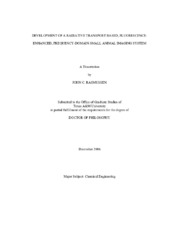| dc.description.abstract | Herein we present the development of a fluorescence-enhanced, frequency-domain radiative transport reconstruction system designed for small animal optical tomography. The system includes a time-dependent data acquisition instrument, a radiative transport based forward model for prediction of time-dependent propagation of photons in small, non-diffuse volumes, and an algorithm which utilizes the forward model to reconstruct fluorescent yields from air/tissue boundary measurements. The major components of the instrumentation include a charge coupled device camera, an image intensifier, signal generators, and an optical switch. Time-dependent data were obtained in the frequency-domain using homodyne techniques on phantoms with 0.2% to 3% intralipid solutions. Through collaboration with Transpire, Inc., a fluorescence-enhanced, frequency-domain, radiative transport equation (RTE) solver was developed. This solver incorporates the discrete ordinates, source iteration with diffusion synthetic acceleration, and linear discontinuous finite element differencing schemes, to predict accurately the fluence of excitation and emission photons in diffuse and transport limited systems. Additional techniques such as the first scattered distributed source method and integral transport theory are used to model the numerical apertures of fiber optic sources and detectors. The accuracy of the RTE solver was validated against diffusion and Monte Carlo predictions and experimental data. The comparisons were favorable in both the diffusion and transport limits, with average errors of the RTE predictions, as compared to experimental data, typically being less than 8% in amplitude and 7% in phase. These average errors are similar to those of the Monte Carlo and diffusion predictions. Synthetic data from a virtual mouse were used to demonstrate the feasibility of using the RTE solver for reconstructing fluorescent heterogeneities in small, non-diffuse volumes. The current version of the RTE solver limits the reconstruction to one iteration and the reconstruction of marginally diffuse, frequency-domain experimental data using RTE was not successful. Multiple iterations using a diffusion solver successfully reconstructed the fluorescent heterogeneities, indicating that, when available, multiple iterations of the RTE based solver should also reconstruct the heterogeneities. | en |


